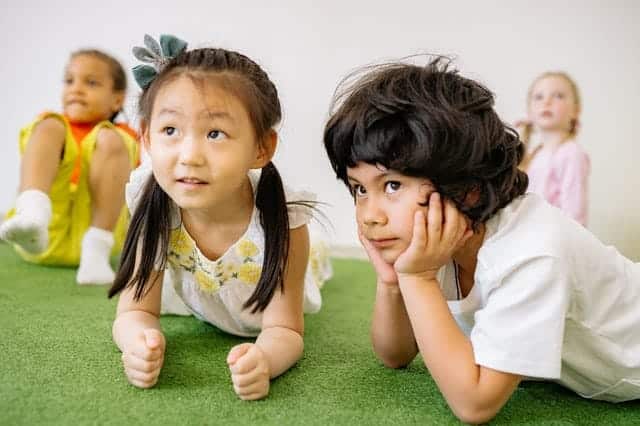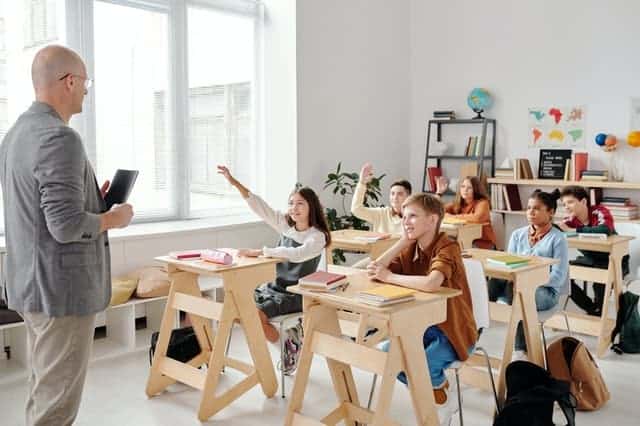When children attentively listen, both their academic performance and relationships can improve. In this article, we’ll discuss active listening and provide examples of listening skills activities to help children develop proficiency in this area.
Listening Skills Activities for Students
Listening skills are an important communication tool that requires practice. It is important to distinguish between listening and hearing, as they are not the same. Many people can recall the sound of rain or music, for example. However, listening to them requires active listening skills. According to Maryville University, active listening requires, “attention, comprehension of the message relayed, and recollection of what’s been said.” This skill is vital for teamwork, problem-solving, leadership, and conflict resolution for kids (Oxford). Listening skills activities teach children to actively listen.
What is Active Listening

Active listening is crucial to learning. These skills are necessary at home and in the classroom. Active listening is defined as giving full attention to the speaker and understanding the complete message that was sent (Oxford). This means understanding both verbal and nonverbal cues. There are four main types of active listening. They include:
-
Appreciative Listening
This type of listening occurs when we pay close attention to what’s said and then respond to the speaker. The listener must actively listen and respond appropriately.
-
Empathetic Listening
Empathetic listening involves hearing another person discuss their problems. It is also known as therapeutic listening. Empathetic listening means giving supportive cues, such as eye contact, and exhibiting empathy.
-
Comprehensive Listening
When we listen without judgment to the speaker’s perspective, we are using comprehensive listening skills. We pay attention to nonverbal and verbal cues. Some of these clues include body language and tone. This type of listening builds trust, friendships, and community.
-
Critical Listening
We use critical listening when we analyze carefully and without bias. This type often occurs when separating facts from opinions. We often do this when we are offered a product or service (Oxford).
These four main types of active listening can be taught to children through activities.
Active Listening Benefits

There are numerous benefits to learning active listening skills. Firstly, students have better comprehension when they actively listen. By paying full attention to the speaker and deeply listening, students retain information. This improves their academic performance in every area, as well as their productivity. In addition, they are typically better critical and mindful thinkers. In short, active listening skills provide enormous cognitive benefits.
Additionally, students improve socially when their communication skills progress. They can resolve conflicts with their classmates and advocate for themselves. This helps reduce disruptions in the classroom and promotes positive action. Good listeners tend to be better liked and have stronger relationships. Therefore, providing listening exercises for students is beneficial in any classroom or home environment.
Listening Activities for Students
KWL Chart
This stands for “Know, Want to Know, and Learned.” Make a chart using a large paper or a whiteboard with three columns labeled K, W, and L. Introduce students to a topic and then listen to what they already know about it. Write highlights of what they know under the “K” section. Encourage students to brainstorm about what they would like to know about the topic. Write their thoughts under the “W” section. Next, give students the vocabulary and background information they will need to understand the topic. Prompt students to listen for 1-2 specific items. Include tone, details, and emotions when teaching. Lastly, have students tell you what they learned and then complete the chart under the “L” section. Provide a follow-up activity such as crafts, writing prompts, or group discussions (Colorado State).
Simon Says
This classic game is perfect for teaching active listening skills. Students have to pay close attention to the speaker. One person stands in front of the classroom and says the task the rest of the class must perform. Then, students have to quickly perform the activity. However, they can only do it if the speaker says, “Simon Says.” If those words aren’t used, the children doing the activity are “out” for that game.
Telephone
This game is great for kids from preschool up to high school. In this game, the teacher or a student makes up an appropriate phrase or sentence. Then the message is whispered to the next student until it is passed around by the entire class. The goal is to have the correct message revealed at the end. This game shows students the importance of active listening and is a fun way to hone their skills.
Group Story
In this game, students actively listen to everyone’s ideas. One person starts by saying a few words (1-3 works well for younger students, 3-5 for older students). Then the next person adds to it, based on what was said in the previous sentence. For example, if one student says, “My pet bunny,” the next person should say something like, “likes eating carrots.” The goal of the activity is for students to listen and repeat the full story at the end.
Mindful Meditation
Have students sit or lay down quietly. Utilize mindfulness in the classroom activities such as guided meditation or a mindful body scan as discussed here. This helps teach students to listen and focus.
Sound Scavenger Hunt
This game can be conducted in several different ways. Scavenger hunts can be inside or outside. In this activity, children hunt for sounds. Have children sit quietly and try to focus on the sounds they hear and identify the sound. They can move around the room and pinpoint sounds, or they can find sounds outdoors. The sounds can be as specific or general as you wish. (Waterford).
Copycat
This game involves having students actively listen and then kinesthetically respond. A teacher or student can stand at the front of the classroom to begin. A simple movement is best to start, such as clapping hands or snapping fingers. Whatever the appointment leader does, the rest of the class imitates (Seattle Education). You can make this activity more challenging by performing multiple gestures at once or a sequence of gestures, which requires more attention to repeat.
Some listening skills activities take 5 minutes or less. They are a quick way to sharpen students’ cognitive skills. Active listening exercises for students promote success. Although it can be difficult to make the time, the benefits far outweigh the time spent.
Soul Shoppe provides social emotional learning programs, including mindfulness, inclusivity, allyship, conflict resolution strategies for students, and more. Click here to learn more about SEL programs for elementary schools.
You May Also Like:
Building Community in the Classroom
Empathy for Elementary Students
Virtual Social Emotional Learning Activities
Sources:
Colorado State, Marysville University, Oxford, Seattle Education, Unicef, Waterford

